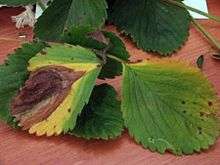Phomopsis obscurans
| Phomopsis obscurans | |
|---|---|
 | |
| V-shaped lesion on a strawberry leaf | |
| Scientific classification | |
| Kingdom: | Fungi |
| Phylum: | Ascomycota |
| Class: | Sordariomycetes |
| Subclass: | Sordariomycetidae |
| Order: | Diaporthales |
| Family: | Diaporthaceae |
| Genus: | Phomopsis |
| Species: | Phomopsis obscurans |
| Binomial name | |
| Phomopsis obscurans (Ellis & Everh.) B. Sutton, (1965) | |
| Synonyms | |
|
Dendrophoma obscurans (Ellis & Everh.) H.W. Anderson, (1920) | |
Phomopsis obscurans (leaf blight) is a common disease-causing fungus affecting strawberry plants. Although the fungus infects leaves early in the growing season, leaf blight symptoms are most apparent on older leaves near or after harvest. The disease can weaken strawberry plants through the destruction of older foliage. Weakened plants can result in reduced yields the following year. In years highly favorable for disease development, leaf blight can cause defoliation and, in some cases, death of plants.
The fungus can also cause a fruit rot called soft rot, especially in warmer climates, which can result in serious losses.
Symptoms
Symptoms of leaf blight infections begin as one to several circular reddish-purple spots on a leaflet. Spots enlarge to V-shaped lesions with a light brown inner zone and dark brown outer zone. Lesions follow major veins progressing inward. The whole leaflet may turn brown. In severe cases, stolons, fruit trusses and petioles may become infected which may girdle and kill the stem.
Prevention and control
There are no varieties with reported resistance to leaf blight but these cultural practices should help reduce infection:
- Remove the older and infected leaves from runner plants before setting.
- Take care in spacing runner plants in matted-row culture.
- Plant in light, well-drained soil in a location exposed to all-day sun and good air circulation.
- Control weeds in the planting. Weeds reduce air circulation and increase drying time for leaves. (Leaves stay wet longer in weedy plantings.)
- Removing infected leaves after harvest (during renovation) is helpful in reducing inoculum and controlling leaf diseases.
- The bacteria Pseudomonas fluorescens is a proven biocontrol agent to control this fungal disease in an environment friendly way.